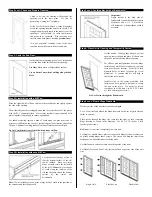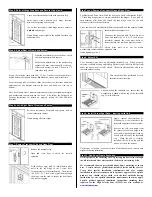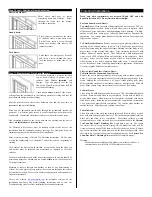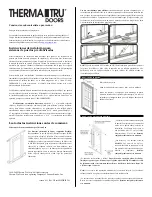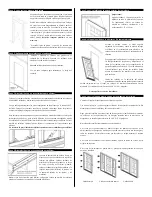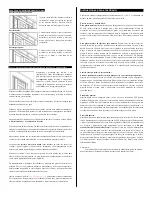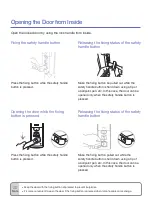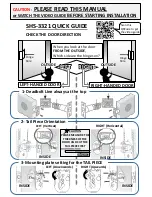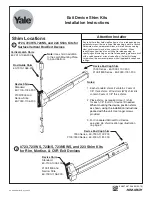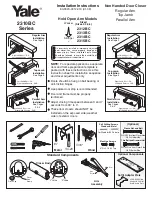
Builder, Subcontractor or Supplier:
Please forward these instructions to the homeowner.
The application performance standards for these products may be governed by
the International Residential Code, International Building Code and other state
and jurisdictional requirements. Copies of performance ratings are available
on our website at
www.thermatru.com
.
Installation Instructions for
Pre-hung Door Systems
These installation instructions are designed to assist door installers who have
an understanding of carpentry principles, and know how to properly and
safely use power tools. The purpose of these instructions is to illustrate how
to install a Therma-Tru door system using methods and materials that help
eliminate water related leaks. If the directions are closely followed, the door
system will have a long useful life with good resistance to rain related water
intrusion problems.
These methods are “tried and true” They are used widely by builders and
remodelers who are serious about managing and keeping water outside the
home. Rather than eliminate any steps that may be unclear to you, please call
1-800-THERMATRU and ask for clarification. If you remain unclear, please
seek more professional assistance with the installation.
Different parts of the country have different code requirements, which may
not be covered in these instructions. The installer is responsible for insuring
the installation complies with local codes. If you have unique code
requirements that do not appear please contact 1-800-THERMATRU.
Required Tools & Materials:
2 & 6 foot Levels, Hammer, Putty Knives
(firm & flexible), Framing Square, Caulking Gun, Sturdy Ladder, Shims,
Tape Measure, High Quality Elastomeric or Polyurethane Sealant, Screw
Gun/Drill -1/8 inch Drill Bit, Razor Knife, #2 & #3 Philips Bit, Stapler,
Insulating Material, Eye Protection, Water Resistive Barrier, Flashing
Material, #8 x 2-1/2 inch Exterior Grade Screws, & Optional Sill Pan.
Read all instructions before starting.
Therma-Tru Recommended Best Practices
Use Water Resistive Barrier and Flexible Flashing:
We recommend the use of a Water Resistive Barrier
(WRB) applied to the exterior sheathing (OSB or
other) and the use of an adhesive or flexible flashing
product to seal around the opening. The WRB should
be cut in the opening (follow manufacturer’s
guidelines) with the head of the flap taped up, to be
sealed later in Step 11. The flashing should be applied
in an overlapping manner as shown, always working
from the bottom up (follow manufacturer’s
guidelines).
Use a Sill Pan:
We recommend you first “dry fit” the sill pan in the opening,
following the instructions furnished with the sill pan. Place the right and left
sill pan ends tight against the sides of the opening. Check the center section
for proper length and if necessary, cut with a hack saw or tin snips. Be sure to
allow 2 inches of overlap at the joints.
Note:
Use only the PVC cement provided in the sill pan kit to glue the pieces
together. The sill pan must be sealed to the sub-floor using an Elastomeric or
Polyurethane sealant, but do not apply sealant to the bottom of the sill when
using a sill pan.
Step 1: Check Door Unit.
Check width and height.
Measure size of frame (width and height), not
brickmould.
Remove cleats and packaging, but keep door
fastened closed with transport clip. Do Not
remove the transport clip until instructed to do
so later in Step 7.
Step 2: Check and Prepare Opening.
Is the opening the correct size for the
door unit? Check it against the door
frame size now, before installation. The
opening should be frame height plus 1/2
inch, and frame width plus 1/2 inch to
3/4 inch.
Fix any problems now.
Are the framing and walls
PLUMB
? Use
a 6 foot level and check both sides of the
opening, both ways (front to back and
right to left).
Fix any problems now.
Is the sub floor level and solid?
Provide
a flat, level, clean weight bearing
surface so the sill pan or sill can be
properly caulked and sealed to the
opening. Scrape sand or fill as required.
Note:
If additional floor covering clearance is required, attach the shim board
to the sub floor. Be sure to caulk well under the shim board.
Is the opening square? Check all corners with a framing square. Double check
by comparing diagonal measurements.
Fix any problems now.


